Evaluation Method for Nitrogen Oxide Emission Reduction Using Hypothetical Automobile Model: A Case in Guangdong Province
Abstract
1. Introduction
2. Data and Methods
2.1. General Situation
2.2. Data Introduction
2.2.1. Number of ICEVs in Guangdong Province
2.2.2. Number of NEVs in Guangdong Province from 2018 to 2022
2.3. Method
2.3.1. Calculation of Number of NEVs in Guangdong Province
2.3.2. Calculation of NOx Emissions from Automobiles in Guangdong Province
2.3.3. Accounting Model for NOx Emission from ICEVs and NEVs
2.3.4. Proportion of Emission Reductions for ICEVs and NEVs
3. Results and Discussion
3.1. Annual Variation in Near-Surface NO2 in Guangdong Province
3.2. Accounting for NOx Automobile Emissions in Guangdong Province
3.2.1. The Number of NEVs in Guangdong Province from 2018 to 2022
3.2.2. NOx Emissions from Automobiles in Guangdong Province from 2013 to 2022
3.3. Evaluation of Emission Reduction Effectiveness of NEVs and ICEVs
3.3.1. Accounting for the Share of NOx Emissions from NEVs and ICEVs
3.3.2. Calculation of the Proportion of Emission Reduction Between NEVs and ICEVs
4. Conclusions and Policy Recommendations
4.1. Conclusions
4.2. Policy Recommendations
Author Contributions
Funding
Institutional Review Board Statement
Informed Consent Statement
Data Availability Statement
Conflicts of Interest
References
- Alvarado-Molina, M.; Curto, A.; Wheeler, A.J.; Tham, R.; Cerin, E.; Nieuwenhuijsen, M.; Vermeulen, R.; Donaire-Gonzalez, D. Improving traffic-related air pollution estimates by modelling minor road traffic volumes. Environ. Pollut. 2023, 338, 122657. [Google Scholar] [CrossRef]
- Emissions Control Technologies to Meet Current and Future European Vehicle Emissions Legislation; Association for Emissions Control by Catalyst: Brussels, Belgium, 2020.
- Yulong, S.; Yue, P.; Biwu, C. Control status and emission reduction strategies of nitrogen oxides in key industries in China. Res. Environ. Sci. 2023, 36, 431–438. [Google Scholar]
- Gao, X.L.; Hu, T.J.; Wang, K. Research on motor vehicle exhaust pollution monitoring technology. Appl. Mech. Mater. 2014, 620, 244–247. [Google Scholar] [CrossRef]
- Wang, F.; Zhao, J.; Li, T.; Guan, P.; Liu, S.; Wei, H.; Zhou, L. Research on NOx Emissions Testing and Optimization Strategies for Diesel Engines Under Low-Load Cycles. Atmosphere 2025, 16, 190. [Google Scholar] [CrossRef]
- Vijai, C.; Babu, M.D.; Babu, M.N.; Sathiyamoorthi, R.; Sathyanarayanan, S.; Sathya, V.; KamakshiPriya, K.; Alemayehu, H. Optimizing Combustion Efficiency and Emission Reduction in Low Temperature Combustion Engines Using Biodiesel-Nano Additive Alcohol Blends: A Review. Results Eng. 2025, 27, 106175. [Google Scholar] [CrossRef]
- Lu, C. Analysis of China’s New Energy Vehicle Industry. In Proceedings of the 2022 7th International Conference on Financial Innovation and Economic Development (ICFIED 2022), Online, 14–16 January 2022. [Google Scholar]
- Zheng; Li, W.; Cui, K.; Cheng, X.; Huang, J. Reevaluating the Impact of New Energy Vehicles: A Vehicle Substitution Pattern Analysis on Comprehensive Emission Reduction Effects. Energy 2025, 318, 134834. [Google Scholar] [CrossRef]
- Chen, A.; You, S. The Fuel Cycle Carbon Reduction Effects of New Energy Vehicles: Empirical Evidence Based on Regional Data in China. Sustainability 2022, 14, 16003. [Google Scholar] [CrossRef]
- Bishop, S. How We Can Reduce Vehicle Emissions and Air Pollution. 2024. Available online: https://www.clarity.io/blog/air-pollution-traffic-monitoring-strategies-for-reducing-emissions-in-big-cities (accessed on 5 April 2025).
- Manzueta, R.; Kumar, P.; Arino, A.H.; Martín-Gomez, C. Strategies to reduce air pollution emissions from urban residential buildings. Sci. Total Environ. 2024, 951, 175809. [Google Scholar] [CrossRef]
- Zhou, H.; Cen, K.; Fan, J. Modeling and optimization of the NOx emission characteristics of a tangentially fired boiler with artificial neural networks. Energy 2004, 29, 167–183. [Google Scholar] [CrossRef]
- Simpkins, G. Benefits of electric vehicle adoption. Nat. Rev. Earth Environ. 2023, 4, 432. [Google Scholar] [CrossRef]
- Feng, R.; Li, Z. Current investigations on global N2O emissions and reductions: Prospect and outlook. Environ. Pollut. 2023, 338, 122664. [Google Scholar] [CrossRef] [PubMed]
- Amin, L. Control of nitrogen oxide emission from vehicular engines: Brief perspectives. Austin Environ. Sci. 2019, 4, 1–2. [Google Scholar]
- Akopov, A.S.; Beklaryan, L.A.; Saghatelyan, A.K. Agent-based modelling of interactions between air pollutants and greenery using a case study of Yerevan, Armenia. Environ. Model. Softw. 2019, 116, 7–25. [Google Scholar] [CrossRef]
- Wei, J.; Li, Z.; Lyapustin, A.; Wang, J.; Dubovik, O.; Schwartz, J.; Sun, L.; Li, C.; Liu, S.; Zhu, T. First close insight into global daily gapless 1 km PM2.5 pollution, variability, and health impact. Nat. Commun. 2023, 14, 8349. [Google Scholar] [CrossRef]
- Han, L.; Wang, Y.; Li, J.; Fang, S. Investigations on Driving Factors of Coordination Development of Rural Infrastructure and Ecological Environment: The Case of Western China. Buildings 2024, 14, 858. [Google Scholar] [CrossRef]
- People’s Government of Guangdong Province. Buy a New Car and Enjoy a Maximum Subsidy of 20,000 yuan. 2024. Available online: https://www.gd.gov.cn/zwgk/zcjd/mtjd/content/post_4485665.html (accessed on 10 March 2025).
- Guangdong Provincial Energy Bureau. Notice from Guangdong Provincial Energy Bureau on Issuing the Construction Tasks for Electric Vehicle Charging Infrastructure in 2024. 2024. Available online: https://drc.gd.gov.cn/gdsnyj/gkmlpt/content/4/4357/mpost_4357571.html#4247 (accessed on 10 March 2025).
- People’s Government of Guangdong Province. Macroeconomic Performance of Guangdong Province in 2020. 2020. Available online: https://www.gd.gov.cn/zwgk/sjfb/sjkx/content/post_3184233.html (accessed on 10 March 2025).
- Guan, Y.; Shan, Y.; Hang, Y.; Nie, Q.; Liu, Y.; Hubacek, K. Unlocking global carbon reduction potential by embracing low-carbon lifestyles. Nat. Commun. 2025, 16, 1–16. [Google Scholar] [CrossRef]
- Wu, M. Analysis of fuel consumption limits and measurement methods for commercial trucks. Highw. Automot. Appl. 2010, 25–29. Available online: https://d.wanfangdata.com.cn/periodical/glyqy201005008 (accessed on 10 March 2025).
- Dong, M.A.; Feng, A.N.; Kang, L.; Earley, R. Corporate average fuel consumption (CAFC) and its limit standard of passenger vehicle in China. J. Automot. Saf. Energy Effic. 2012, 3, 364–370. [Google Scholar]
- Xun, S.; Wei, W. Testing the fuel consumption of operating buses based on JT/T 711-2016 standard. Small Intern. Combust. Engines Veh. Technol. 2022, 3, 68–72. Available online: https://www.nstl.gov.cn/paper_detail.html?id=5a66b17a0fe46b2f246cd94a92dd9803 (accessed on 10 March 2025).
- Transportation Standardization Information System. Limits and Measurement Methods of Fuel Consumption for Commercial Vehicle for Cargos Transportation. 2025. Available online: https://jtst.mot.gov.cn/hb/search/stdHBDetailed?id=ed3cb0cd88047a22e1dcab01fd963fb6 (accessed on 10 March 2025).
- Ouyang, T.; Wang, C.; Yu, Z.; Stach, R.; Mizaikoff, B.; Huang, G.B.; Wang, Q.J. NOx measurements in vehicle exhaust using advanced deep ELM networks. IEEE Trans. Instrum. Meas. 2020, 70, 1–10. [Google Scholar] [CrossRef]
- Zhang, W.; Zuo, C.; Liao, T.; Zhou, G.; Zhao, D. Research on improving the performance of motor vehicle exhaust gas detection system based on DOAS technology. In Proceedings of the Ninth Symposium on Novel Photoelectronic Detection Technology and Applications (NDTA 2022), Hefei, China, 21–23 April 2023; p. 12617. [Google Scholar]
- Li, Y.; Chen, Y. Development of an SBM-ML model for the measurement of green total factor productivity: The case of pearl river delta urban agglomeration. Renew. Sustain. Energy Rev. 2021, 145, 111131. [Google Scholar] [CrossRef]
- Wu, J.; Wang, Y.; Liang, J.; Yao, F. Exploring common factors influencing PM2.5 and O3 concentrations in the Pearl River Delta: Tradeoffs and synergies. Environ. Pollut. 2021, 285, 10.1016. [Google Scholar] [CrossRef]
- Li, Y.; Shi, G.; Chen, Z. Spatial and temporal distribution characteristics of ground-level nitrogen dioxide and ozone across China during 2015–2020. Environ. Res. Lett. 2021, 16, 124031. [Google Scholar] [CrossRef]
- Shen, Y.; Jiang, F.; Feng, S.; Zheng, Y.; Cai, Z.; Lyu, X. Impact of weather and emission changes on NO2 concentrations in China during 2014–2019. Environ. Pollut. 2021, 269, 116163. [Google Scholar] [CrossRef] [PubMed]
- Lu, T.; Wang, D.; Yang, X.; Li, Z.; Xia, H.; Song, Z.; Yang, Y.; Mo, Y.; Wang, J. Integrated modeling and quantitative analysis of N2O emission before and after COVID-19: A case in Guangdong Province. Sustain. Energy Technol. Assess. 2025, 77, 104313. [Google Scholar] [CrossRef]
- Yang, L.; Franco, V.; Campestrini, A.; German, J.; Mock, P. NOx Control Technologies for Euro 6 Diesel Passenger Cars; International Council on Clean Transportation: Berlin, Germany, 2015. [Google Scholar]
- Chen, H.; Sener, S.E.C.; Van Emburg, C.; Jones, M.; Bogucki, T.; Bonilla, N.; Ijeoma, M.W.; Wan, H.; Carbajales-Dale, M. Electric light-duty vehicles have decarbonization potential but may not reduce other environmental problems. Commun. Earth Environ. 2024, 5, 476. [Google Scholar] [CrossRef]
- Reichmuth, D. Today’s Electric Vehicles Can Greatly Reduce Emissions from Driving. 2023. Available online: https://blog.ucs.org/dave-reichmuth/todays-electric-vehicles-can-greatly-reduce-emissions-from-driving/ (accessed on 10 March 2025).
- Zhang, W.-B.; Xie, Z.-H.; Yu, C.-J. The Influence of Industrial Structure Adjustment on Carbon Emissions: An Analysis Based on the Threshold Effect of Green Innovation. Sustainability 2024, 16, 6935. [Google Scholar] [CrossRef]
- Adegbite, A.O.; Nwasike, C.N.; Nwaobia, N.K.; Gidiagba, J.O.; Enabor, O.T.; Dawodu, S.O.; Adefemi, A.; Ezeigweneme, C.A. Modern electric motors: A review of sustainable design and maintenance principles: Scrutinizing the latest trends focusing on motor efficiency, sustainability, recyclability, and reduced maintenance. World J. Adv. Res. Rev. 2023, 20, 1198–1211. [Google Scholar] [CrossRef]
- IDTechEx. The Role of Electric Motors in Sustainable Electric Vehicles. 2024. Available online: https://www.innovationnewsnetwork.com/the-role-of-electric-motors-in-sustainable-electric-vehicles/51854/ (accessed on 10 March 2025).
- Li, R.; Han, X.; Wang, Q. Do technical differences lead to a widening gap in China’s regional carbon emissions efficiency? Evidence from a combination of LMDI and PDA approach. Renew. Sustain. Energy Rev. 2023, 182, 113361. [Google Scholar] [CrossRef]
- Wang, Y.; Wang, R.; Tanaka, K.; Ciais, P.; Penuelas, J.; Balkanski, Y.; Zhang, R. Accelerating the energy transition towards photovoltaic and wind in China. Nature 2023, 619, 761–767. [Google Scholar] [CrossRef]
- Suman, D.; Rajak, S. Sustainable product design for electric vehicles. In Progress in Sustainable Manufacturing; Springer: Berlin/Heidelberg, Germany, 2023; pp. 31–44. [Google Scholar]
- Chinese Social Sciences Network. New Productive Forces to Invigorate Real Economy. 2024. Available online: http://english.cssn.cn/skw_research/economics/202401/t20240117_5729325.shtml (accessed on 10 March 2025).
- Rodrigues, A.L.; Seixas, S.R. Battery-electric buses and their implementation barriers: Analysis and prospects for sustainability. Sustain. Energy Technol. Assess. 2022, 51, 101896. [Google Scholar] [CrossRef]
- Liu, Y.; Ding, Y.; Jiang, P.; Jin, X.; Wu, X.; Zheng, Z. Joint Optimal Design of Electric Bus Service and Charging Facilities. Sustainability 2024, 16, 6155. [Google Scholar] [CrossRef]
- Department of Ecology and Environmental of Guangdong Province. The Implementation Plan for Ozone Pollution Prevention and Control (Coordinated Reduction of Nitrogen Oxides and Volatile Organic Compounds) in Guangdong Province from 2023 to 2025. 2023. Available online: https://gdee.gd.gov.cn/wj5666/content/post_4097395.html (accessed on 10 March 2025).
- Sayarshad, H.R. Optimization of electric charging infrastructure: Integrated model for routing and charging coordination with power-aware operations. NPJ Sustain. Mobil. Transp. 2024, 1, 4. [Google Scholar] [CrossRef]
- Mohammed, A.; Saif, O.; Abo-Adma, M.A.; Elazab, R. Multiobjective optimization for sizing and placing electric vehicle charging stations considering comprehensive uncertainties. Energy Inform. 2024, 7, 131. [Google Scholar] [CrossRef]
- People’s Government of Guangdong Province. Notice of the General Office of the People’s Government of Guangdong Province on Issuing the 14th Five Year Plan for Energy Development in Guangdong Province. 2022. Available online: https://www.gd.gov.cn/zwgk/wjk/qbwj/yfb/content/post_3909371.html (accessed on 10 March 2025).
- Muthusamy, T.; Meyyappan, U.; Thanikanti, S.B.; Khishe, M. Enhancing distribution system performance by optimizing electric vehicle charging station integration in smart grids using the honey badger algorithm. Sci. Rep. 2024, 14, 27341. [Google Scholar] [CrossRef]
- Li, Z.; Niu, S.; Wang, J.; Tan, Y.; Wang, Z. Multidimensional assessment of energy transition and policy implications. Renew. Energy 2025, 238, 121870. [Google Scholar] [CrossRef]
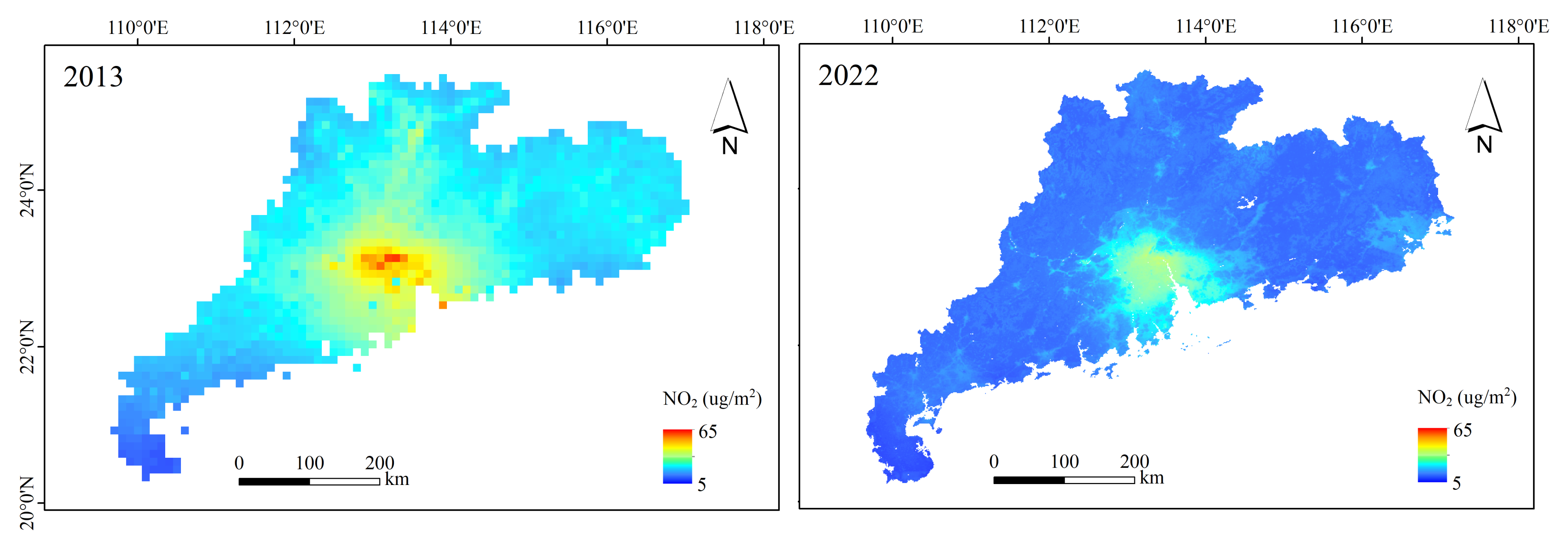
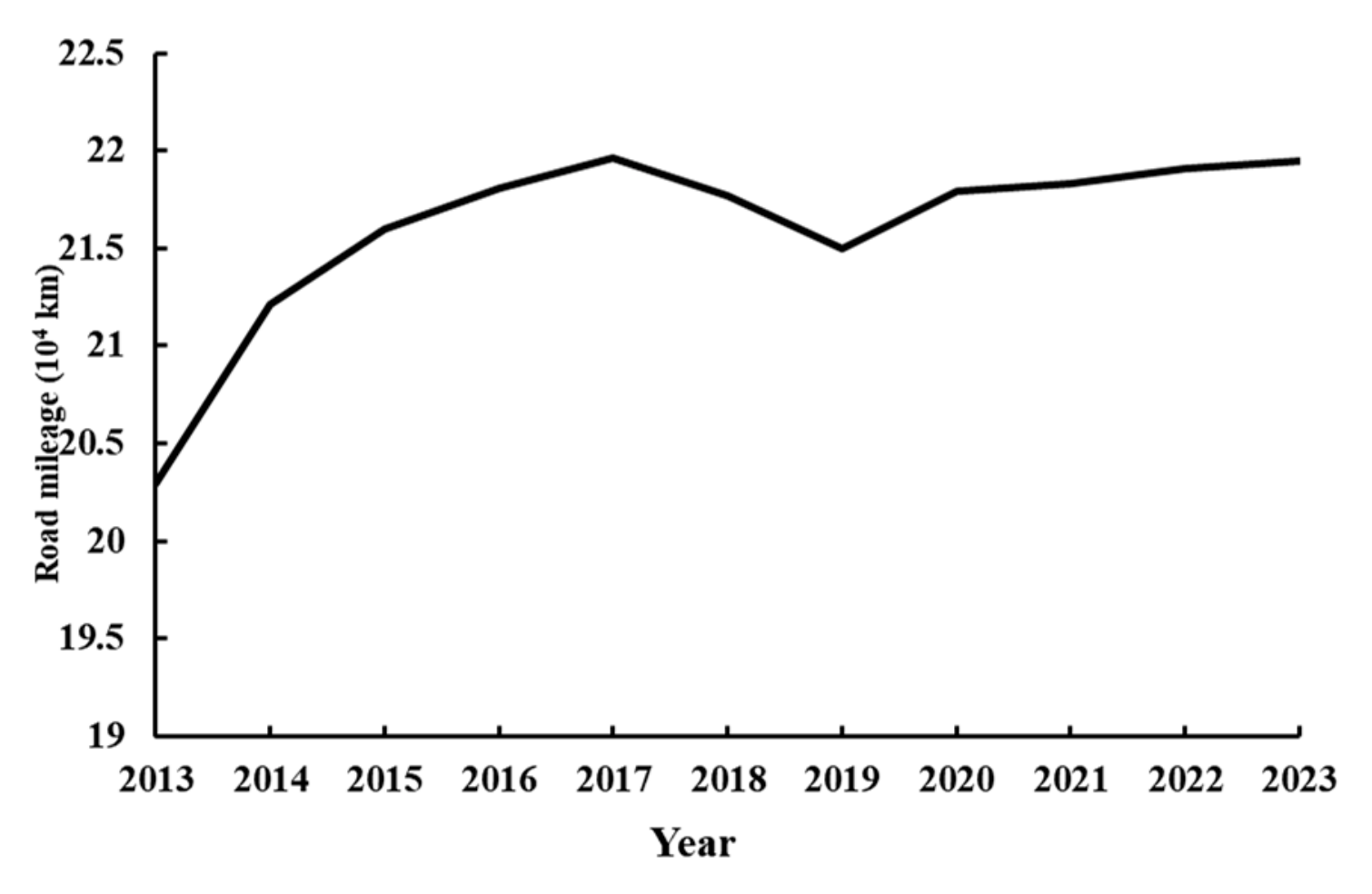
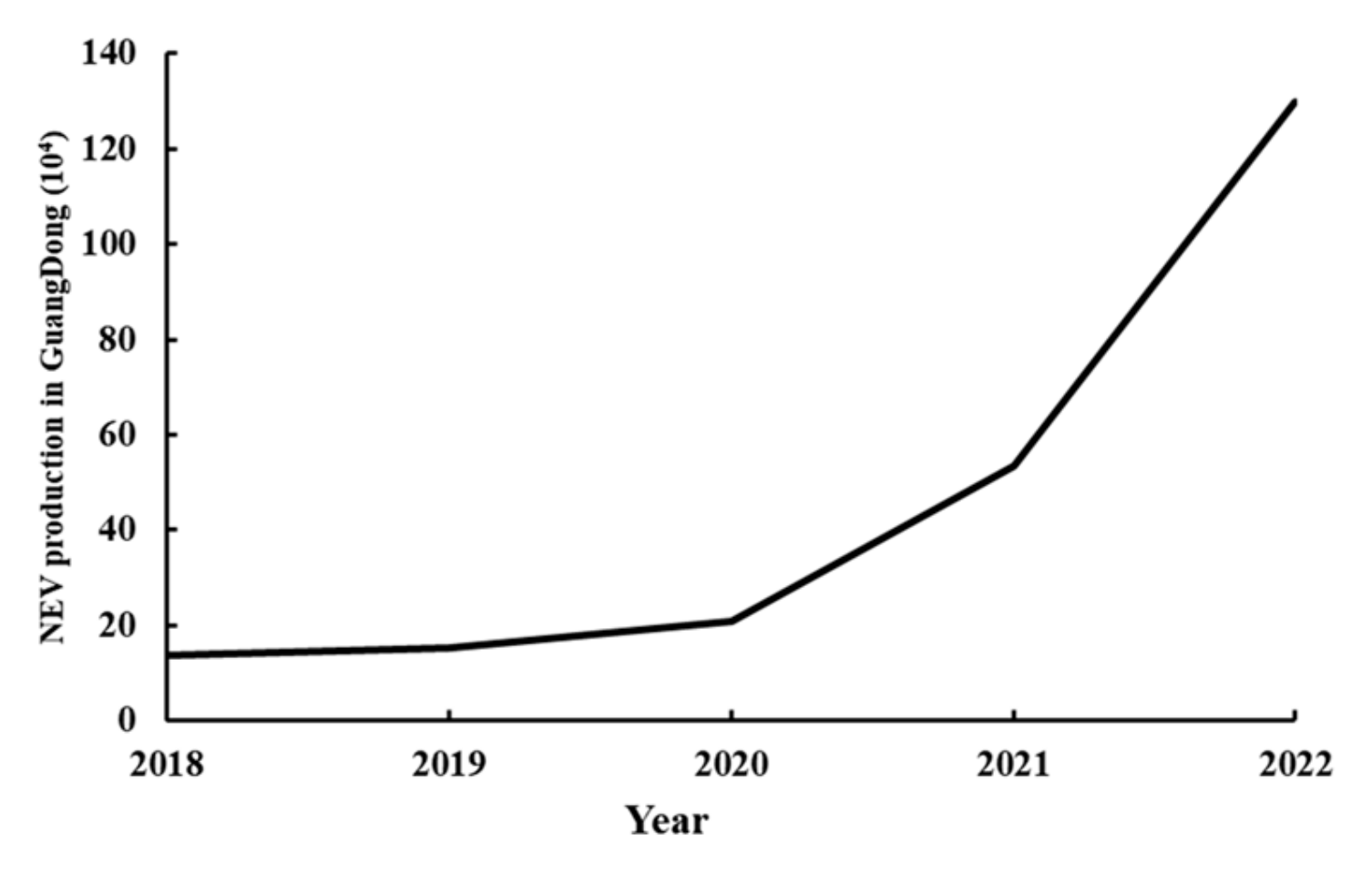


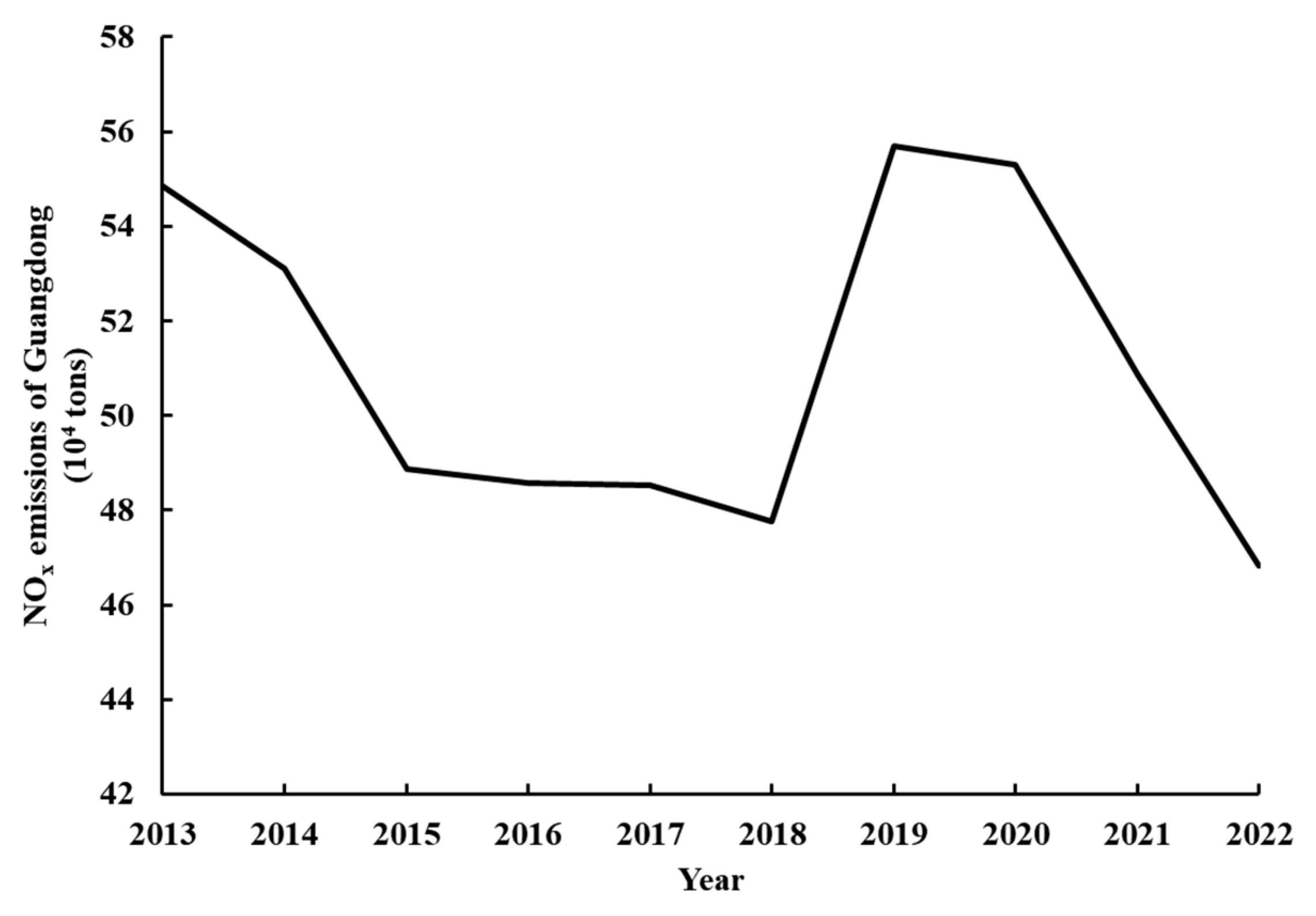
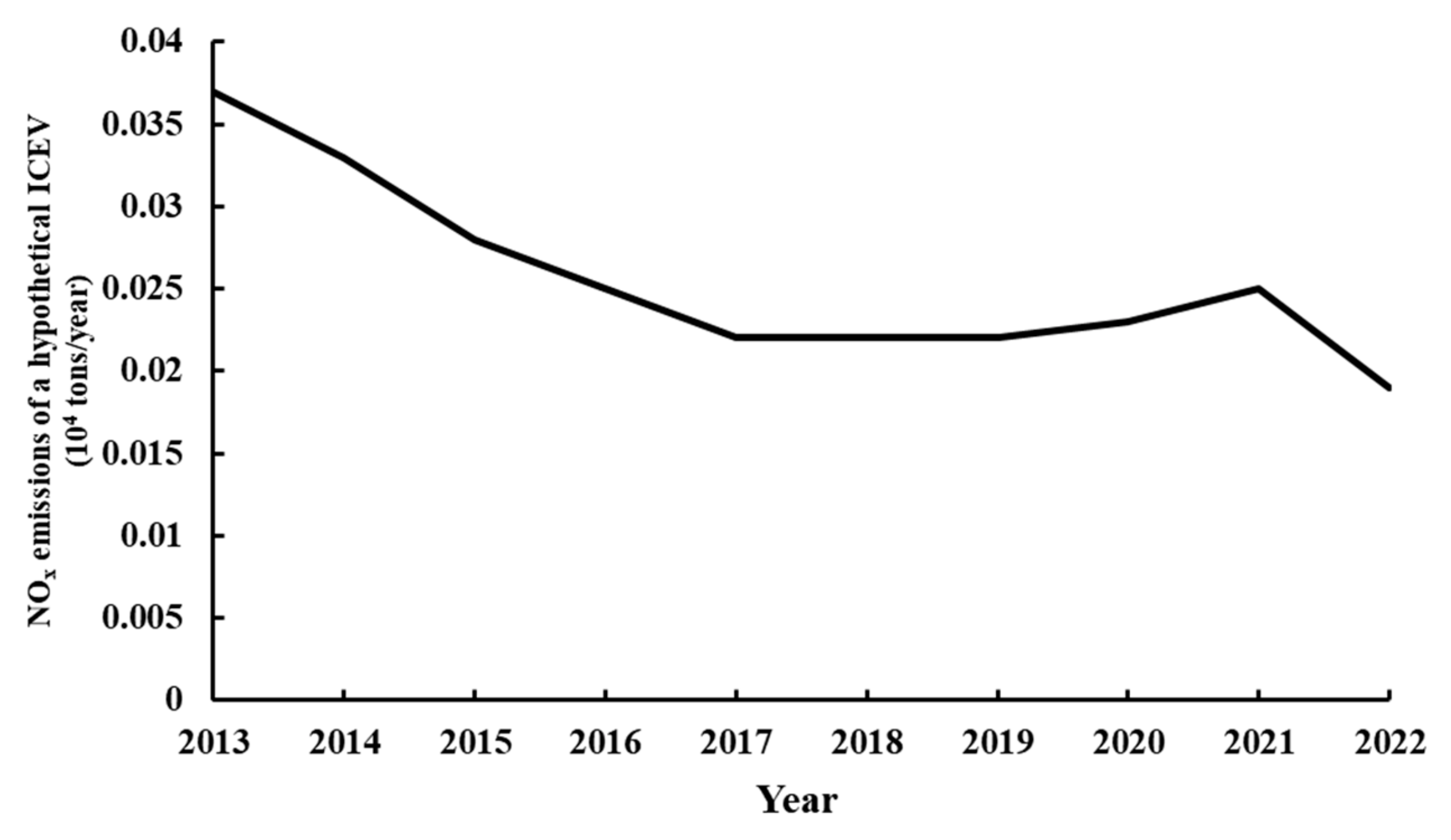
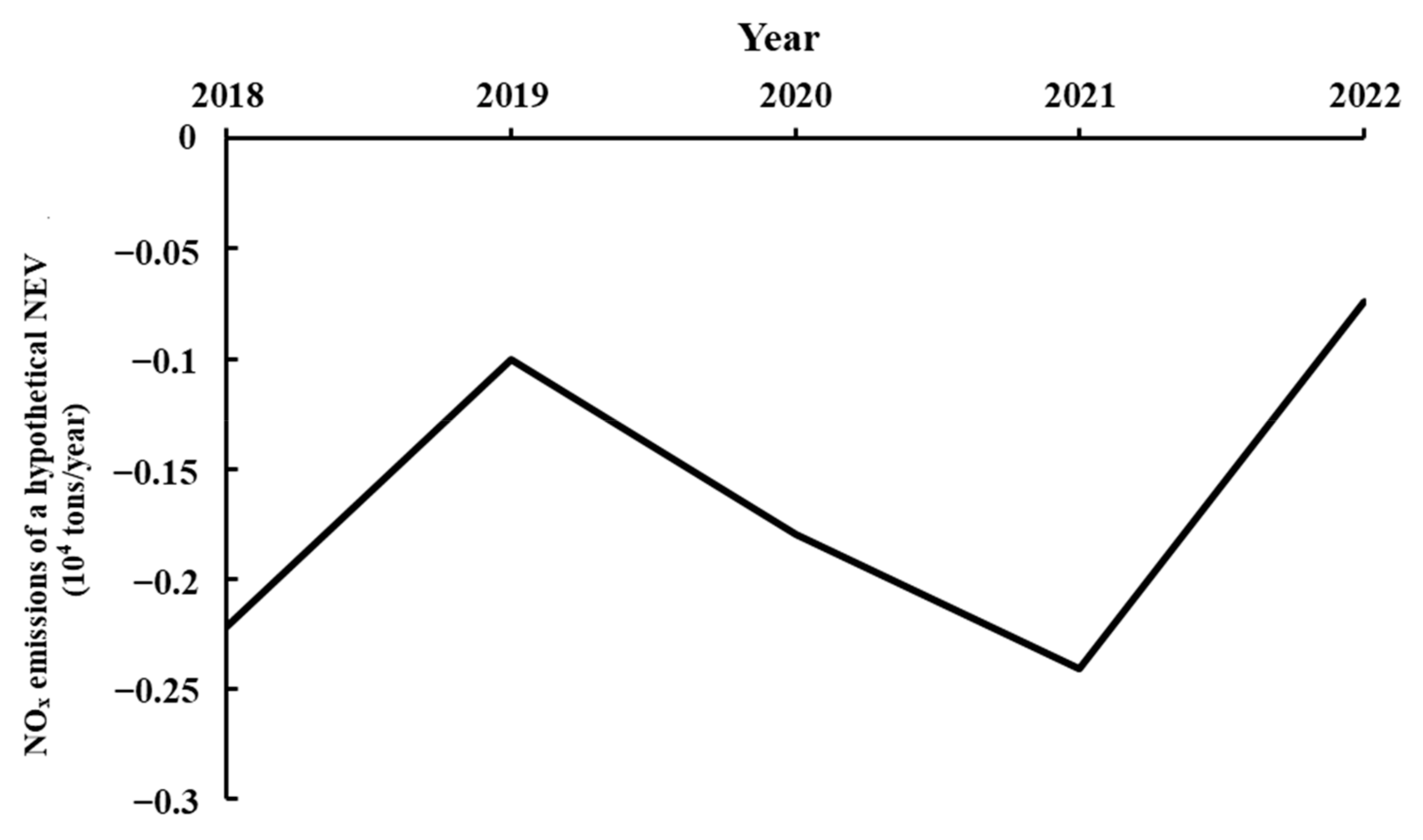

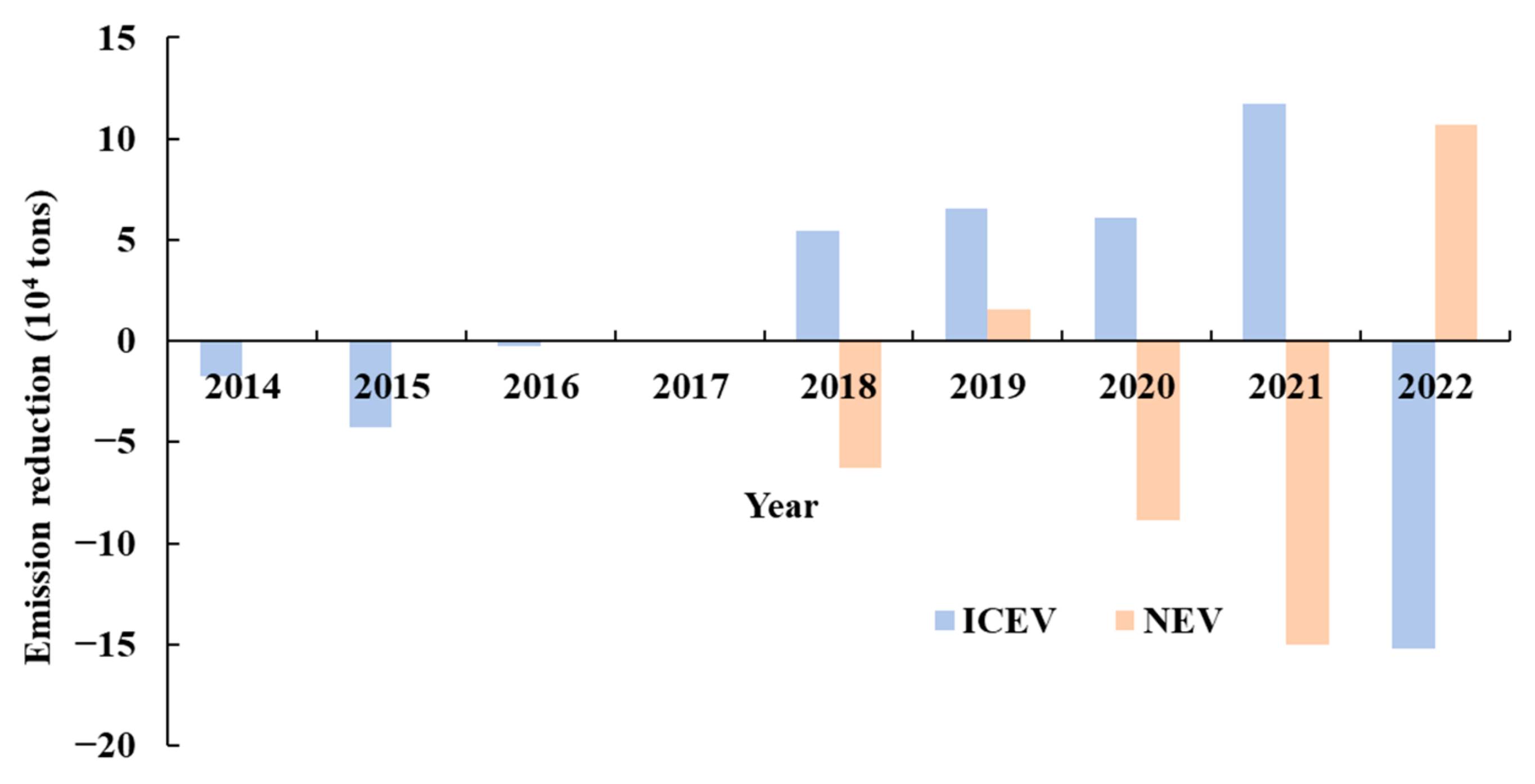
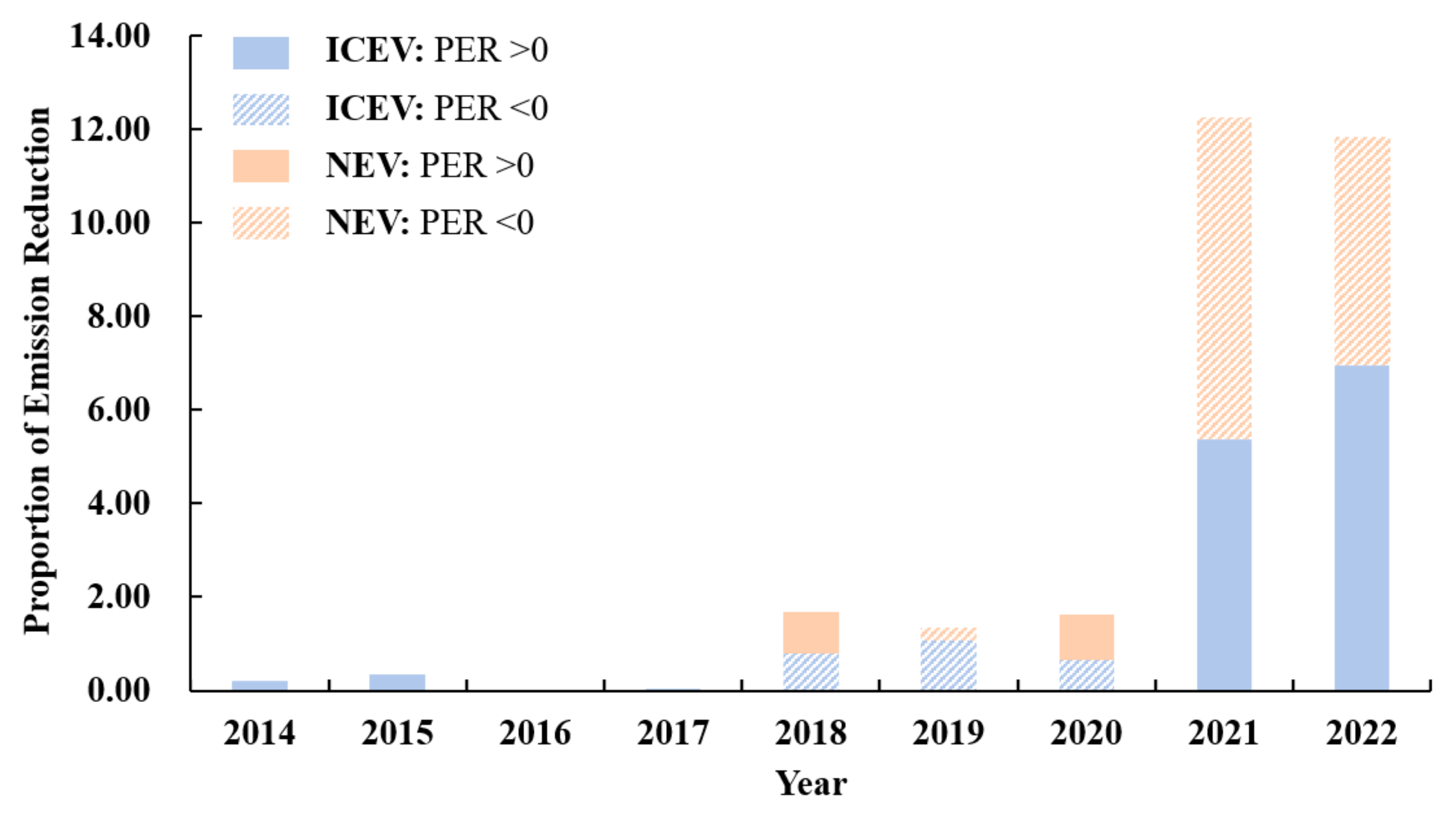
| Year/Type Large | Large Freight | Medium Freight | Light Freight | Mini Freight | Large Passenger | Medium Passenger | Compact Passenger | Mini Passenger |
|---|---|---|---|---|---|---|---|---|
| 2013 | 23.2 | 17.74 | 134.57 | 3.38 | 15.62 | 16.88 | 947.69 | 12.21 |
| 2014 | 25.83 | 15.83 | 136.69 | 3.49 | 15.41 | 13.58 | 1103.63 | 11.56 |
| 2015 | 26.36 | 12.9 | 132.2 | 3.44 | 15.31 | 8.72 | 1256.25 | 10.3 |
| 2016 | 29.09 | 12.45 | 138.58 | 2.90 | 16.3 | 7.44 | 1453.45 | 8.46 |
| 2017 | 33.25 | 11.81 | 148.49 | 2.45 | 17.47 | 6.49 | 1660.09 | 7.91 |
| 2018 | 37.71 | 11.46 | 166.45 | 2.29 | 17.67 | 5.66 | 1860.01 | 7.96 |
| 2019 | 42.4 | 11.13 | 181.95 | 2.03 | 17.51 | 5.14 | 2050.77 | 7.55 |
| 2020 | 49.36 | 10.78 | 197.63 | 1.72 | 16.64 | 4.67 | 2203.72 | 6.93 |
| 2021 | 56.56 | 10.13 | 213.75 | 1.31 | 15.72 | 4.37 | 2384.04 | 6.34 |
| 2022 | 55.37 | 9.13 | 219.67 | 0.88 | 14.63 | 3.96 | 2576.32 | 5.65 |
| Year | National NEV In-Use Stock | National NEV Output | Guangzhou NEV Output |
|---|---|---|---|
| 2018 | 261 | 127 | 13.67 |
| 2019 | 381 | 124.2 | 15.26 |
| 2020 | 492 | 136.6 | 20.87 |
| 2021 | 784 | 354.5 | 53.5 |
| 2022 | 1310 | 705.8 | 129.73 |
| Year | Automobile Stock b (104) | Travel Distance c (104 km) | Fuel Consumption d (kg/km) |
|---|---|---|---|
| Mini/compact | 2390.3 | 1.8 | 0.056 |
| Medium | 4.36 | 3.13 | 0.163 |
| Large | 8.94 | 5.8 | 0.163 |
| Taxi | 5.41 | 12 | / |
| Mini/light-duty | 213.77 | 3 | 0.105 |
| Medium-duty | 10.13 | 3.5 | 0.157 |
| Heavy-duty | 56.56 | 7.5 | 0.252 |
| Year | NO2 Concentration (μg/m3) |
|---|---|
| 2013 | 25.689 |
| 2014 | 25.714 |
| 2015 | 21.437 |
| 2016 | 21.474 |
| 2017 | 23.753 |
| 2018 | 23.368 |
| 2019 | 17.624 |
| 2020 | 16.239 |
| 2021 | 16.239 |
| 2022 | 15.487 |
| Year | National Automobile Stock (104) | Guangdong Automobile Stock (104) | National NOx Emissions (104 tons) | Guangdong NOx Emissions (104 tons) |
|---|---|---|---|---|
| 2013 | 12,572.4 | 1171.3 | 588.7 | 54.84587748 |
| 2014 | 14,452.2 | 1326 | 578.9 | 53.1145016 |
| 2015 | 16,169.7 | 1465.5 | 539.1 | 48.85996957 |
| 2016 | 18,435.8 | 1675.5 | 534.6 | 48.58602827 |
| 2017 | 20,816 | 1896 | 532.8 | 48.52943889 |
| 2018 | 23,121.8 | 2116 | 521.9 | 47.76186975 |
| 2019 | 26,000 | 2326.95 | 622.2 | 55.68570346 |
| 2020 | 28,100 | 2532.29 | 613.7 | 55.30485313 |
| 2021 | 30,200 | 2702 | 568.5 | 50.86380795 |
| 2022 | 31,900 | 2896 | 515.9 | 46.83531034 |
| Year | (104 tons/Year) | (104 tons/Year) |
|---|---|---|
| 2013 | 0.037 | / |
| 2014 | 0.033 | / |
| 2015 | 0.028 | / |
| 2016 | 0.025 | / |
| 2017 | 0.022 | / |
| 2018 | 0.022 | −0.222 |
| 2019 | 0.022 | −0.10 |
| 2020 | 0.023 | −0.18 |
| 2021 | 0.025 | −0.241 |
| 2022 | 0.019 | −0.074 |
| Simulated Logarithmic Mean | 0.026 | −0.163 |
| 95% Confidence Interval | (0.0254, 0.0261) | (−0.169, −0.157) |
Disclaimer/Publisher’s Note: The statements, opinions and data contained in all publications are solely those of the individual author(s) and contributor(s) and not of MDPI and/or the editor(s). MDPI and/or the editor(s) disclaim responsibility for any injury to people or property resulting from any ideas, methods, instructions or products referred to in the content. |
© 2025 by the authors. Licensee MDPI, Basel, Switzerland. This article is an open access article distributed under the terms and conditions of the Creative Commons Attribution (CC BY) license (https://creativecommons.org/licenses/by/4.0/).
Share and Cite
Wang, D.; Shen, J.; Zhuang, Z.; Lu, T.; Tang, X.; Xia, H.; Song, Z.; Yan, C.; Li, Z.; Yang, X.; et al. Evaluation Method for Nitrogen Oxide Emission Reduction Using Hypothetical Automobile Model: A Case in Guangdong Province. Sustainability 2025, 17, 7334. https://doi.org/10.3390/su17167334
Wang D, Shen J, Zhuang Z, Lu T, Tang X, Xia H, Song Z, Yan C, Li Z, Yang X, et al. Evaluation Method for Nitrogen Oxide Emission Reduction Using Hypothetical Automobile Model: A Case in Guangdong Province. Sustainability. 2025; 17(16):7334. https://doi.org/10.3390/su17167334
Chicago/Turabian StyleWang, Dakang, Jiwei Shen, Zirui Zhuang, Tianyu Lu, Xiao Tang, Hui Xia, Zhaolong Song, Chenglong Yan, Zhen Li, Xiankun Yang, and et al. 2025. "Evaluation Method for Nitrogen Oxide Emission Reduction Using Hypothetical Automobile Model: A Case in Guangdong Province" Sustainability 17, no. 16: 7334. https://doi.org/10.3390/su17167334
APA StyleWang, D., Shen, J., Zhuang, Z., Lu, T., Tang, X., Xia, H., Song, Z., Yan, C., Li, Z., Yang, X., & Wang, J. (2025). Evaluation Method for Nitrogen Oxide Emission Reduction Using Hypothetical Automobile Model: A Case in Guangdong Province. Sustainability, 17(16), 7334. https://doi.org/10.3390/su17167334









